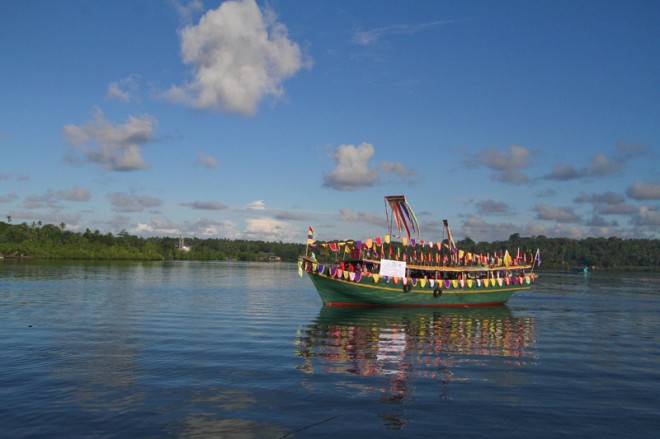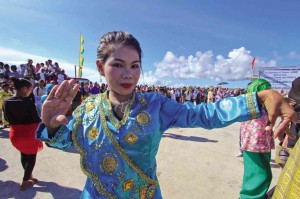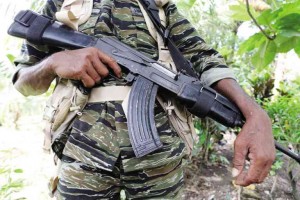Bangsamoro to inherit poorer ARMM

A BOAT festooned with colorful decorations joins the fluvial parade from Bongao to Simunul in Tawi-Tawi province at the start of festivities for the 25th anniversary of the Autonomous Region in Muslim Mindanao.
COTABATO CITY—Once established, a Bangsamoro government is bound to inherit a poorer region 25 years after the Autonomous Region in Muslim Mindanao (ARMM) was created after its charter was ratified in a plebiscite on Nov. 9, 1989.
Republic Act No. 6734, or the Organic Act for the ARMM, which was approved by Congress and later amended for an expanded autonomy under RA 9054, has the same intent as the proposed Bangsamoro Basic Law (BBL): To end conflict and defeat poverty by establishing a limited autonomy for a Moro self-rule.
In the region’s “last anniversary,” ARMM officials say they want to make sure that poverty indicators will be addressed squarely, including the lack of schools, learning and health facilities, rural infrastructure for agriculture and tourism development.

DRESSED in traditional attire, a girl performs a local dance at the port of Simunul town in Tawi-Tawi province to welcome guests at the 25th anniversary celebration of the Autonomous Region in Muslim Mindanao.
The poverty incidence among families rose to 48.7 percent in 2012 from 39.9 percent in 2009 and 40.5 percent in 2006. But the good news, officials say, starts with Tawi-Tawi province, where the poverty incidence dropped twice in 2012 to 21.9 percent from 29.4 percent in 2009 and 50.2 percent in 2006.
The four other provinces of the region have been poorer, the 2012 census showed in figures made available by the National Statistical Coordination Board (NSCB): Basilan, 32.1 percent (28.1 percent in 2009); Lanao del Sur, 67.3 percent (48.7 percent in 2009); Maguindanao, 54.5 percent (43.3 percent in 2009); and Sulu, 40.2 percent (35.5 percent in 2009).
Displaced families
Regional Gov. Mujiv Hataman says more than 80 percent of the 3,248,787 population of the ARMM live in rural areas, where families are prone to displacement due to armed skirmishes and natural calamities, such as floods.
The frequent displacement of families tends to increase the number of dependents to income earners.
But Hataman foresees improvement in the poverty index in 2015, when the next NSCB census, which is conducted every three years, is completed.
He cites the rise in the region’s investments in 2013 to P1.463 billion, with 1,743 in added employment opportunity slots. It posted twice as much the 2012 level of P569.0 million, which generated 1,016 slots, and about 10 times higher than the 2010 level of P174.7 million, which created 487 slots.
Hataman owes this to what he calls good housekeeping, and reforms that his administration had to go through from previous gargantuan problems, which included corruption in the form of “ghost” payments, employees, roads, schools and students that existed only in documents.
Basic services
In the ARMM, an income earner should take home at least P20,517 monthly to feed more jobless dependents because of frequent family displacement, compared with P18,000 to P19,000 in neighboring regions or even the national standard of P18,935, the region’s planning officials say.

A MORO rebel stands guard during the ceremony for the turnover of the Bangsamoro Development Plan to leaders of the Moro Islamic Liberation Front in Sultan Kudarat, Maguindanao province. JEOFFREY MAITEM
While Hataman considers the crafting of peace deals half the Moro people’s fight against poverty, he says the other half is the challenge for the government to ensure basic social, health and infrastructure services are in place by the time the ARMM starts a bilateral transition of transforming into a Bangsamoro government by the middle of next year.
Regional Public Works Secretary Emil Sadain says the region’s unpaved roads have been reduced to only 158.556 linear kilometers, by having concreted 616.3 linear km in 2011, 778.748 linear km in 2012 and 834.024 linear km in 2013. The incoming Bangsamoro government would inherit some P2 billion worth of infrastructure projects, consisting mostly of roads, bridges, water systems and school buildings.
The literacy rate in the ARMM remains low at 71.6 percent, compared with Central Mindanao’s 78.3 percent; Caraga’s 85.7 percent, and the whole country’s 86.4 percent.
Regional Education Secretary Jamar Kulayan says 2,709 more classrooms must be completed to cope with shortage in learning facilities, including school chairs catering to an average of three students per chair, and a classroom for 62 to 82 students in some areas in Lanao del Sur and Tawi-Tawi, and Maguindanao, Basilan and Sulu.
DAP funds
Secretary Makmod Mending of the ARMM’s Department of Agriculture and Fisheries says the government and the farmers have delved into high-value crop shifting and the promotion of organic farming.
He says the region should intensify efforts on irrigation development, but the National Irrigation Administration (NIA) has not been devolved to the ARMM, which is left with barely 21,031 hectares of irrigated lands out of its total 177,993 ha of potential rice areas that need to be irrigated.
Mending says agriculture and fishery will be the broadest base of development that can host the transformation of Moro Islamic Liberation Front (MILF) guerrillas in the period of normalization.
Regional Interior Secretary Anwar Malang admits that the use of the controversial Disbursement Acceleration Program (DAP) funds helped the ARMM establish rural water systems in 74 “waterless municipalities” for P500 million in “one-shot” allocation from the national government.
On orders of Hataman, the ARMM has stopped using DAP funds after the Supreme Court ruled it unconstitutional in August last year. Instead, to minimize displacement caused by floods, Malang says, his department sought the cooperation of local government units to support the national government’s massive flood control program, through the Mindanao Development Authority.